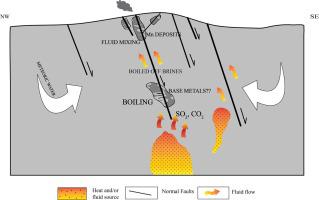当前位置:
X-MOL 学术
›
Ore Geol. Rev.
›
论文详情
Our official English website, www.x-mol.net, welcomes your feedback! (Note: you will need to create a separate account there.)
Geochemical constraints on the genesis of the ‘Montaña de Manganeso’vein-type Mn deposit, Mexican Plateau
Ore Geology Reviews ( IF 3.3 ) Pub Date : 2020-10-01 , DOI: 10.1016/j.oregeorev.2020.103680 Joseph Madondo , Carles Canet , Eduardo González-Partida , Augusto A. Rodríguez-Díaz , Fernando Núñez-Useche , Pura Alfonso , Abdorrahman Rajabi , Teresa Pi , Lauren Blignaut , Nicholas Vafeas
Ore Geology Reviews ( IF 3.3 ) Pub Date : 2020-10-01 , DOI: 10.1016/j.oregeorev.2020.103680 Joseph Madondo , Carles Canet , Eduardo González-Partida , Augusto A. Rodríguez-Díaz , Fernando Núñez-Useche , Pura Alfonso , Abdorrahman Rajabi , Teresa Pi , Lauren Blignaut , Nicholas Vafeas

|
Abstract Manganese mineralization at Montana de Manganeso, San Luis Potosi state, consists of oxide ores that form sharp contacts with volcanic host rocks. The orebodies are generally in the form of veins and irregular masses, and locally as mineralized breccias. Petrographic analyses indicate that the mineralization is multi-episodic, with colloform and crustiform textures predominating. The X-ray diffraction and electron microscopy show that manganese oxides (todorokite, birnessite, pyrolusite, romanechite and cryptomelane) are the main ore minerals, while iron oxides (goethite and hematite) are accessory. The most common gangue minerals are calcite and quartz with subordinate amounts of barite. According to fluid inclusion microthermometry, the mineralization is associated with aqueous solutions of intermediate salinity (8 to 16 wt.% NaCl equivalent) and temperatures between 101 and 140 °C. Stable isotope analysis of calcite (δ13CPDB: -7.76 to -6.32 ‰; δ18OPDB: -8.01 to -4.71 ‰) and barite (δ34S: 7.9 to 13.6 ‰) shows a contribution of magmatic volatiles to hydrothermal fluids dominated by meteoric water (calculated δ18Ofluid: 6.58 to 13.14 ‰, relative to SMOW). Argillic alteration is the most widespread hydrothermal alteration at Montana de Manganeso and indicates fluid temperature below ∼150 °C and near neutral pH. Much more local, advanced argillic alteration, revealed by the occurrence of kaolinite, is interpreted as a steam-heated overprint, which in turn suggests a boiling process that must have happened at greater depths. The Mn ores formed through a process of mixing of: (a) boiled-off hydrothermal fluids, with (b) cold, diluted meteoric water. Our results support a hot-spring deposit model, according to which Montana de Manganeso corresponds to the shallowest portion of an epithermal system formed in a continental volcanic arc setting.
中文翻译:

墨西哥高原'Montaña de Manganeso'脉型锰矿床成因的地球化学约束
摘要 圣路易斯波托西州 Montana de Manganeso 的锰矿化由与火山主岩形成尖锐接触的氧化物矿石组成。矿体一般呈脉状和不规则块状,局部呈矿化角砾岩。岩相分析表明,矿化是多幕的,以胶状和壳状结构为主。X射线衍射和电镜结果表明,锰氧化物(绿锰矿、水钠锰矿、软锰矿、罗锰矿和锂锰矿)是主要的矿石矿物,而铁氧化物(针铁矿和赤铁矿)是次要的。最常见的脉石矿物是方解石和石英,其次是重晶石。根据流体包裹体显微测温法,矿化作用与中等盐度(8 至 16 重量%)的水溶液有关。% NaCl 当量)和 101 至 140 °C 之间的温度。方解石(δ13CPDB:-7.76 至 -6.32 ‰;δ18OPDB:-8.01 至 -4.71 ‰)和重晶石(δ34S:7.9 至 13.6 ‰)的稳定同位素分析表明岩浆挥发物对以 δ18O : 6.58 到 13.14 ‰,相对于 SMOW)。泥质蚀变是 Montana de Manganeso 最普遍的热液蚀变,表明流体温度低于 150 °C 且接近中性 pH。高岭石的出现揭示了更多局部的、高级的泥质蚀变,被解释为蒸汽加热的叠印,这反过来表明一定发生在更深处的沸腾过程。Mn 矿石是通过以下混合过程形成的:(a) 沸腾的热液,(b) 冷的、稀释的大气水。
更新日期:2020-10-01
中文翻译:

墨西哥高原'Montaña de Manganeso'脉型锰矿床成因的地球化学约束
摘要 圣路易斯波托西州 Montana de Manganeso 的锰矿化由与火山主岩形成尖锐接触的氧化物矿石组成。矿体一般呈脉状和不规则块状,局部呈矿化角砾岩。岩相分析表明,矿化是多幕的,以胶状和壳状结构为主。X射线衍射和电镜结果表明,锰氧化物(绿锰矿、水钠锰矿、软锰矿、罗锰矿和锂锰矿)是主要的矿石矿物,而铁氧化物(针铁矿和赤铁矿)是次要的。最常见的脉石矿物是方解石和石英,其次是重晶石。根据流体包裹体显微测温法,矿化作用与中等盐度(8 至 16 重量%)的水溶液有关。% NaCl 当量)和 101 至 140 °C 之间的温度。方解石(δ13CPDB:-7.76 至 -6.32 ‰;δ18OPDB:-8.01 至 -4.71 ‰)和重晶石(δ34S:7.9 至 13.6 ‰)的稳定同位素分析表明岩浆挥发物对以 δ18O : 6.58 到 13.14 ‰,相对于 SMOW)。泥质蚀变是 Montana de Manganeso 最普遍的热液蚀变,表明流体温度低于 150 °C 且接近中性 pH。高岭石的出现揭示了更多局部的、高级的泥质蚀变,被解释为蒸汽加热的叠印,这反过来表明一定发生在更深处的沸腾过程。Mn 矿石是通过以下混合过程形成的:(a) 沸腾的热液,(b) 冷的、稀释的大气水。



























 京公网安备 11010802027423号
京公网安备 11010802027423号